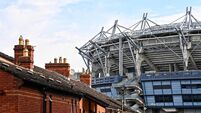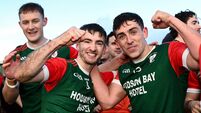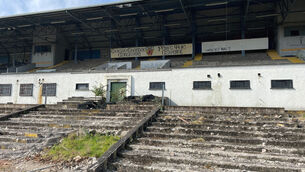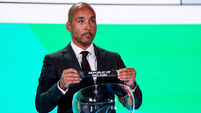Anthony Daly: Pat Ryan wouldn't pull the handbrake so why were Cork so flat?

Driving home from the Gaelic Grounds on Saturday evening, I was giddy with excitement about the end to the league and how much it had whetted my appetite four weeks out from the championship. I was primed for Cork-Kilkenny Sunday but any of that giddiness was soon sapped out of me. It was flat, tepid, like warm beer in high summer.
Pat Ryan is too decent and honourable a man to pull up the handbrake. You could see Pat’s frustration at stages when the TV cameras panned to him but you’d wonder if what happened on Saturday evening in Limerick got into the heads of some Cork players? Are they better to be picking up the small pieces this week than trying to put it all back together in two weeks if Limerick smashed Cork into smithereens?
The row and the way Cork got so riled up in the middle of it will be used as firm evidence to rubbish that claim but it’s still a reasonable theory. If I was a Cork player sitting down with a cup of tea and a biscuit watching Limerick lads railroad Tipp on Saturday, it’s only human nature for you to start wondering if you really need that hassle – and potential risk – before the championship.
Whatever way they were thinking, there was no other excuse for Cork to be so flat because so many lads are still auditioning for championship places. Whatever Pat thinks about some of those lads after yesterday, he has to have concerns now as to how many of them are up to it.
There’s no denying Cork have loads of players but, no matter how many you have on a squad, you can still only start with 15. Does Pat and his management know their best 15?
They can’t really because so many players have been injured. But when they come back – even though some have played very little hurling during the league – do you go back to those tried and trusted lads? On the otherhand, how many of those lads can you really trust either?
Cork have a lot of classy and skilful players but too many of them are still too similar. Yesterday proved that Cork need Seamus Harnedy and Patrick Horgan. Hoggie was only on for a short period but he did make a big difference. Yet how much more is left in Hoggie’s legs? Where is the next young Hoggie? Who is he? Is he on this panel? I’m not sure.
Cork had some decent performers. Tommy O’Connell was abrasive and was always trying to get forward. Shane Barrett clipped three good points. Padraig Power looked lively in the first half but was starved of ball after the break. Outside of those three though, Kilkenny had all the top players on show.
Derek Lyng will be pleased with how this side is shaping up. Eight of the starting team in last year’s All-Ireland final didn’t start here, including their three best forwards – TJ Reid, Adrian Mullen and Eoin Cody.
Tommy Walsh was impressive at full-back. So was Huw Lawlor at centre back. Padraig Walsh was very effective as a go-to guy at corner-back for the short puck out.
Kilkenny are clearly trying to run and work the ball up the field with a shorter game and Paddy Deegan is a huge part of that process in the half-forward line. Whether Paddy has the finesse to make it work as a forward in the championship is a whole different question again. But it has worked so far.
So has the investment in Billy Drennan. The expectation is that Billy will slip back to the bench when TJ returns, but I’m not sure if he will.
Kilkenny were just better. David Blanchfield had a great game, defiant and anxious to get into everything. Mossy Keoghan was lively for the goal. Cian Kenny was electric off the bench. Kilkenny were just livelier everywhere, full stop.
The row was unsightly in how it went on much longer than it should or needed to. I found it difficult to know exactly what Eoin Downey did but Damien Cahalane was lucky not to be red-carded for his swipe on Drennan. You could see that Damien was trying to stop Billy’s batted effort but any belt to the head is walking a fine line.
Kilkenny are exactly where they want to be now, getting ready for another crack off Limerick after last July. I still think they are the one team that may be best equipped to take down Limerick in the summer. We’ll get a much better idea of how well on Saturday week.
When I worked with Cyril Farrell for one year with the LIT Freshers, Cyril’s last word to the players before the game began, and at half-time, was to win the throw-in. I always felt it was an overly simplistic instruction when so much more was going to happen but, I also began to realise that there was a deeper meaning behind Cyril’s words, in how that throw-in could largely set the tone for the half.
William O’Donoghue was lucky he didn’t get a red card for nailing Alan Tynan at the throw-in and, while Tynan hit the deck, he got up straight away and instantly went on to tell O’Donoghue – and Limerick – that he wasn’t going to back down, which he displayed with three first-half points.
The throw-in after half-time though, was equally as instructive as to Limerick’s attitude, and how they were going to approach the second half. Barry Murphy won the ball and took off straight through the centre before being fouled for a converted free.
Murphy had a great second half and, while Tipperary were really impressive, once Limerick upped the ante and the aggression in the second half, there was always only going to be one winner.
Limerick just blitzed Tipp in the third quarter without even having to rely on their full-forward line. Peter Casey’s goal was the decisive blow but it was nearly the first ball Caso had won inside all evening. Yet Limerick didn’t need to feed that line given the way in how they were running and penetrating from deep.
Liam Gordon did his best to let the match flow but it was a very difficult match to referee considering how much hitting and hard tackling was going on. Aside from their opening game against Cork in early February, this was Limerick’s first real test. Tipp tested them to the hilt. They were in Limerick’s faces from the first whistle, but it’s just nearly impossible to sustain that ferocity for a full 70 minutes.
How much does it take out of the likes of a Bonner Maher at this stage of his career? Even the younger guys like Bryan O’Mara and Eoghan Connolly who are still learning the trade, they just haven’t played enough at this level to fully condition themselves for that kind of hardship that Limerick use to eventually grind and wear teams down.
The numbers just reflect that reality, which was really evident in the opening 23 minutes of the second half when Limerick outscored Tipp by 1-12 to 0-4. To be fair to Tipp, they didn’t drop the heads, but when you go that far behind and have lost the initiative, you’re forced to go deeper back the pitch and to rely on long-range efforts for scores.
The flipside then is that you invite Barry Nash and Colin Coughlan and the rest of their defensive cavalry onto you. And the damage they can inflict is lethal.
Liam Cahill will be gutted because nobody has suffered at their hands more than he has. On the other hand, Liam will be happy too because a win against Limerick would have driven the hype machine into overdrive.
This project is far from the finished product and Saturday night will have been another valuable lesson. Liam himself will be sick at another cold and hard reality check from Limerick but this is still a vastly different experience with a different group of players compared to what he had to endure as Waterford manager.
Finally, Westmeath were deserving winners of the relegation final on Saturday. I felt sorry for Laois but they can’t really have any complaints either when you look at their run in the competition compared to Westmeath. Laois had a crack off Antrim and a shot at a young Dublin team to try and get points on the board whereas Westmeath had to go up against Clare, Cork, Limerick, Wexford and Galway.
Westmeath got some bad beatings from some of those sides but some of the lessons they learned from those matches looked to have stood to them on Saturday.







